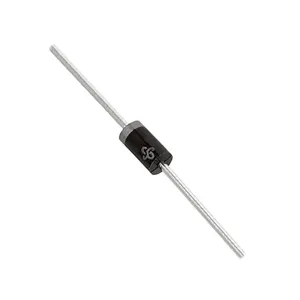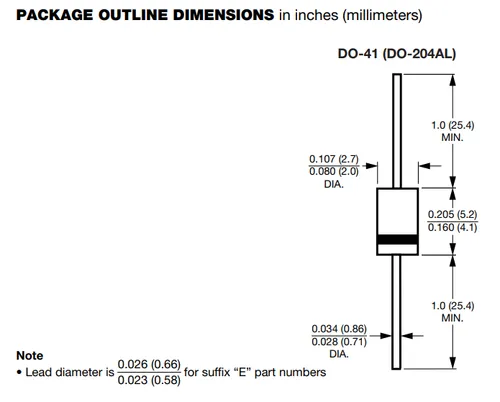DO-204AL (DO-41) Component Package
The DO-204AL (also commonly known as DO-41) component package is a very popular 2-lead through-hole package used for older diodes (incl. the famous 1N400x series1). The pitch is typically 400mil, although because of the long through-hole leads, it is user variable. It is easy to solder by hand. The DO-41 package is normally used for higher power “rectifier” diodes, whilst the lower power “signal” diodes use smaller through-hole packages such as the DO-35. The typical rated current for a diode in this package is 1A.
Synonyms
- DO-204AL (Diode Outline 204 Variant AL): Newer JEDEC name.1
- DO-41 (Diode Outline 41): Older JEDEC name.
- SOD-66: NXP.2
- LALF: NXP “Package Style”.2
Thermal Resistance
Vishay gives the typical junction-to-ambient thermal resistance of a DO-204AL mounted to be . This is when the DO-204AL is mounted horizontally on a PCB with a 9.5mm lead length. The junction-to-lead thermal resistance is 1.
Dimensions and Mounting
This package is normally mounted on the PCB in two ways, either flat with the legs bent at 90° to fit into the holes, or in space-constrained applications, vertical, with one of the legs straight and one bent 180° to fit into the holes in the PCB (which are closer together than when in the flat orientation). Material of package is normally moulded plastic.
Weight of a diode in a DO-41 package is around 0.33g1.
Similar To
Footnotes
-
Vishay (2020, Apr 29). 1N4001, 1N4002, 1N4003, 1N4004, 1N4005, 1N4006, 1N4007 - General Purpose Plastic Rectifier [datasheet]. Retrieved 2024-04-08, from https://www.vishay.com/docs/88503/1n4001.pdf. ↩ ↩2 ↩3 ↩4 ↩5
-
NXP (2016, Feb 8). SOD66: Package Information. Retrieved 2021-09-26, from https://www.nxp.com/docs/en/package-information/SOD66.pdf. ↩ ↩2



